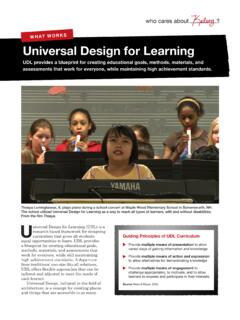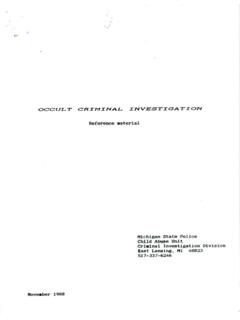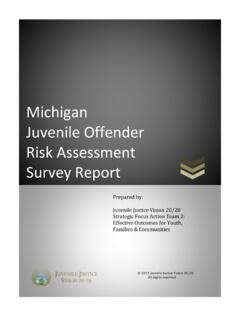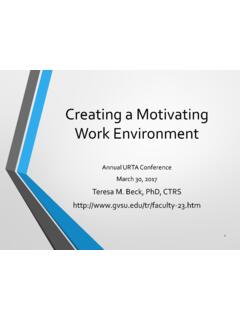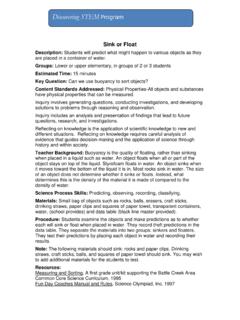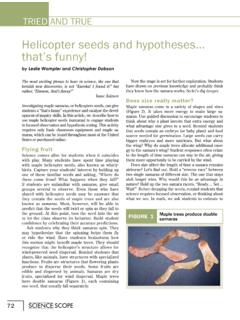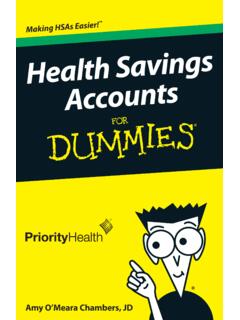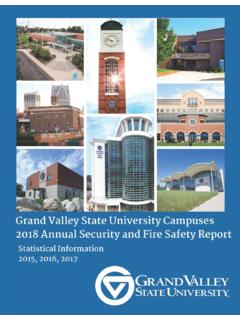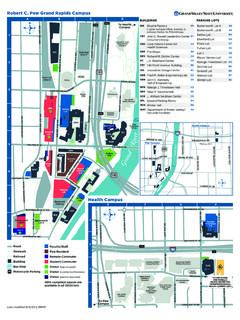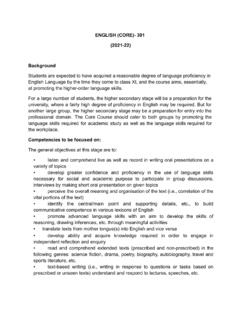Transcription of The Full Technical Report - Grand Valley State University
1 Engineering: The full Technical Report Engineering The full Technical ReportTechnical reports are the primary written work products of engineers. As such, they present facts and conclusions about designs, experiments, and other projects. They include research about Technical concepts and often include visual depictions of designs and data. A Technical Report s purpose is for an engineer to communicate information gained through a process of Technical or experimental work. Therefore, the writing follows a strict sequential process that is sometimes product driven, and which can be replicated exactly. In the engineering workplace, readers of Technical reports include supervisors assessing progress on specific projects or corporate officers evaluating professional recommendations and proposals to invest in new technologies. Usually, readers will have a Technical or engineering background, but it is your responsibility as the Report writer to explain the specifics of the subject of your experiment, process, or basic format of the Technical Report is applicable to most of the writing you will complete in your engineering classes.
2 It, like most scientific or Technical writing , should convey information in an objective, fact-based manner a style that ensures Technical information and processes that can be relayed from you to readers in a clear, efficient fashion. The most important information in Technical reports is the steps you followed or the events that occurred; your opinions should not make their way into the text. The third person, passive voice is required since it allows you to write with more objectivity and keeps the emphasis of the writing on the processes you followed and the products you built, rather than on your experiences or role as a immediate audience is the professor evaluating your understanding of theoretical concepts. Other real or imagined audiences include fellow students, engineering colleagues, or customers seeking engineering services or of a Technical ReportThe Technical Report is a kind of writing you will engage in throughout your academic and professional career.
3 It should include the following PageThe title should be brief and meaningful and describe the contents of the Report . The title identifies the subject and indicates the purpose of the title page includes the title, author s name, course name and number, lab section number, instructor s name, and is not Summary/AbstractEngineering professors typically require either an Executive Summary or an Abstract with Technical reports, but not both. The executive summary should give a concise and clear overview of the entire laboratory experiment or topic to be discussed and should be the main explanation of the entireA Technical Report s purpose is for an engineer to communicate information gained through a process of Technical or experimental Technical Report is a kind of writing you will engage in throughout your academic and professional Brief Overview of Technical ReportsNeed help distinguishing between passive and active voice ?
4 See our handout at Engineering: The full Technical Report Report . Readers should be able to gain all necessary information from the Executive Summary and sometimes will read only this part. It should be written in the third person, passive voice , and past tense because it explains work already section provides a context for the work discussed in the Report . Therefore, it: Defines the experiment/work performed. Defines the scientific purpose or objective for the experiment. Includes a description of the problem and reasons for the work being done. Gives sufficient background information to the Report . Must answer the questions: Why was this study performed? What is the specific purpose of the study?TheoryThis section is mostly embedded in the introduction, especially if it is simple and the paper is reporting a specific sub-task like a lab experiment.
5 Theory explains the Technical background of the work. It usually includes the mathematical equations, models, and formulae, as well as the scientific relations in its final forms, which governs the work, referenced to its original sources. If any derivations are required or needed to backup the work, they are detailed in the appendix and only the beginning and final relations are mentioned in this part, with reference to the appropriate section in the appendix. Any equations or models should be formatted and numbered according to the standards followed in Technical section lists all equipment and materials used in the experiment. Be sure to include identification labels of all SetupThis section provides details of the setup needed to carry out the experiment or work. It could be a circuit diagram or a mechanical Procedure:This section describes and explains the steps and process of the experiment in chronological order.
6 You should:Give detailed information in a paragraph structure that allows the reader to duplicate/repeat the experiment the information in a step-by-step mainly in the passive voice . For help distinguishing between active and passive voice , see our handout at CalculationsThese are part of the results sections. Calculations are usually based on equations and mathematical relations which should have been mentioned earlier in the Theory section. If few calculations are performed, they can be included in this section. If calculations are repetitive and in large numbers, only one sample of each type should be included in this section and the rest can either be performed electronically with results tabulated in the appendix or can be done manually in the appendix. Final results should be summarized in this section with reference to the work in the appendix if need be.
7 A Good Executive Summary/Abstract will Include:The overall purpose of the experiment or principal problem to be methods and materials more assistance in writing an abstract, see our handout at Numerical data should be included in graphs or tables to provide the best possible information about the real situation. Engineering: The full Technical Report Results and DiscussionThe results to the Technical Report should be analyzed, interpreted and stated clearly. The use of figures and tables usually incorporated should have labels referenced in the text and fully explained and interpreted. Any errors should be discussed and explained with regards to how they occurred and how they affected the conclusion. An error analysis is usually an essential part of the discussion and provides a comparison to expected results. Data presented as results should be well organized.
8 Numerical data should be included in graphs or tables to provide the best possible information about the real situation. This section should answer the questions:What do the results clearly indicate?What was discovered?What is the significance of the results?Are the results fully discussed and conclusions drawn based on the knowledge gained?How did errors occur?Did any of the errors affect the conclusion of the experiment/study?ConclusionThis section should briefly summarize the significant results of the experiment. The conclusion:Must answer any questions raised in the introduction regarding what was shown, discovered, verified, proved, or explain why the experiment is explain the implications for your particular field of not include discussion of new information not already mentioned in the information too lengthy to fit within the body of the paper is placed in an appendix.
9 Typically appendices are used for long mathematical formulas and complete sets of data such as tables or figures. All appendices should be referenced within the text of the Report ; items in the appendices should be arranged in the order in which they are mentioned in the Report for writing ConsultationsDoes the abstract summarize the point of the paper? The problem? The methods used? The results? Do the paragraphs within a section flow in a logical order? Do the ideas in each section flow from general to specific, big picture to small?Does the Report show readers how an experiment was conducted or how a process was completed?Are the results written about so clearly that the process could be replicated exactly?Does the thesis sentence look similar to: The purpose of this Report is ..? (In engineering writing , it should!)Are tables, figures, and diagrams (usually in an appendix) fully interpreted and understandable?
10 Can readers grasp the significance of tables and graphs? Notes on voice and ToneGood writing in engineering adheres to the following principles:Stay objective. Eliminate opinions and ( I think or I feel ) from your writing so that the emphasis remains on the Technical and scientific processes and mostly in the third person, passive voice . Doing so keeps your writing looking/sounding objective and helps you to put emphasis on processes and things, rather than on yourself as a technician or scientist. ( writing tip: do a search for I, me, and my in your Report . If you find those words, see if you can rework the sentences so that the emphasis is not on you, but rather on the science and technology under discussion.)Use past tense and present tense appropriately. Use past tense to describe things that have already happened, and use present tense to indicate those things that are still occurring.
